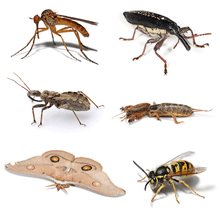Pterygota
The Pterygota are a subclass of insects that includes the winged insects. It also includes insect orders that are secondarily wingless (that is, insect groups whose ancestors once had wings but that have lost them as a result of subsequent evolution).[1]
| Pterygota | |
|---|---|
_on_Tribulus_terrestris_W_IMG_1020.jpg) | |
| Giant honey bee Apis dorsata on Tribulus terrestris (order Hymenoptera) | |
| Scientific classification | |
| Kingdom: | Animalia |
| Phylum: | Arthropoda |
| Class: | Insecta |
| (unranked): | Dicondylia |
| Subclass: | Pterygota Lang, 1888 |
| Orders | |
For alternative classifications and fossil orders, see text. | |
The pterygotan group comprises almost all insects. The insect orders not included are the Archaeognatha (jumping bristletails) and the Zygentoma (silverfishes and firebrats), two primitively wingless insect orders. Also not included are the three orders no longer considered to be insects: Protura, Collembola, and Diplura.
Systematics
Traditionally, this group was divided into the infraclasses Paleoptera and Neoptera. The former are nowadays strongly suspected of being paraphyletic, and better treatments (such as dividing or dissolving the group) are presently being discussed. In addition, it is not clear how exactly the neopterans are related among each other. The Exopterygota might be a similar assemblage of rather ancient hemimetabolous insects among the Neoptera like the Palaeoptera are among insects as a whole. The holometabolous Endopterygota seem to be very close relatives, indeed, but nonetheless appear to contain several clades of related orders, the status of which is not agreed upon.
The following scheme uses finer divisions than the one above, which is not well-suited to correctly accommodating the fossil groups.
Infraclass Palaeoptera
(probably paraphyletic)
- Ephemeroptera (mayflies)
- Palaeodictyoptera †(extinct)
- Megasecoptera †(extinct)
- Archodonata †(extinct)
- Diaphanopterodea †(extinct)
- Protodonata or Meganisoptera †(extinct; sometimes included in Odonata)
- Protanisoptera †(extinct; sometimes included in Odonata)
- Triadophlebioptera †(extinct; sometimes included in Odonata)
- Protozygoptera or Archizygoptera †(extinct; sometimes included in Odonata)
- Odonata (dragonflies and damselflies)
Infraclass Neoptera
Superorder Exopterygota
- Caloneurodea †(extinct)
- Titanoptera †(extinct)
- Protorthoptera †(extinct)
- Plecoptera (stoneflies)
- Embioptera (webspinners)
- Zoraptera (angel insects)
- Dermaptera (earwigs)
- Orthoptera (grasshoppers, etc.)
- Phasmatodea (stick insects - tentatively placed here)
- Notoptera (gladiators and ice-crawlers - tentatively placed here)
- Proposed superorder Dictyoptera
- Blattodea (cockroaches and termites)
- Mantodea (mantids)
- Alienoptera †(extinct)
- Proposed superorder Paraneoptera
- Psocoptera (booklice, barklice)
- Thysanoptera (thrips)
- Phthiraptera (lice)
- Hemiptera (true bugs)
Superorder Endopterygota
- Hymenoptera (ants, bees, etc.)
- Coleoptera (beetles)
- Strepsiptera (twisted-winged parasites)
- Raphidioptera (snakeflies)
- Megaloptera (alderflies, etc.)
- Neuroptera (net-veined insects)
- Proposed superorder Mecopteroidea/Antliophora
- Proposed superorder Amphiesmenoptera
Neoptera orders incertae sedis
- Glosselytrodea †(extinct)
- Miomoptera †(extinct)
References
- Vincent H. Resh; Ring T. Cardé (4 April 2003). Encyclopedia of Insects. Academic Press. p. 64. ISBN 978-0-08-054605-6.
External links
![]()
